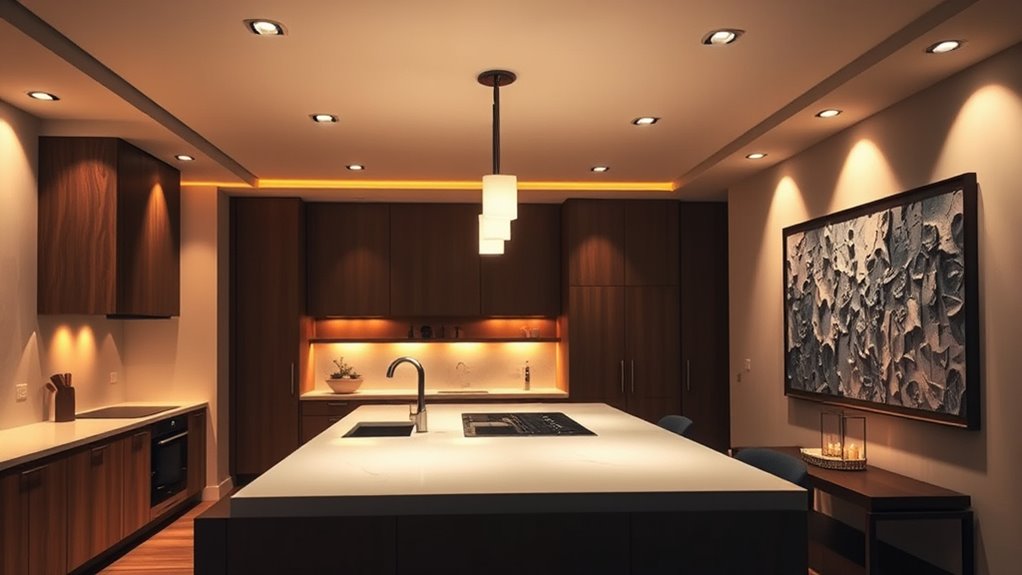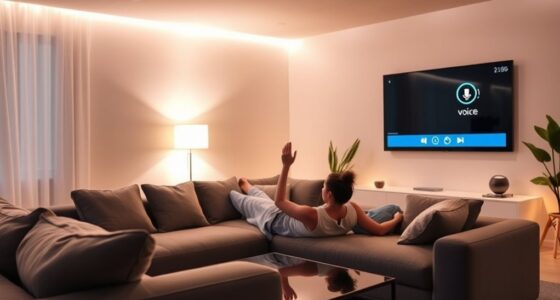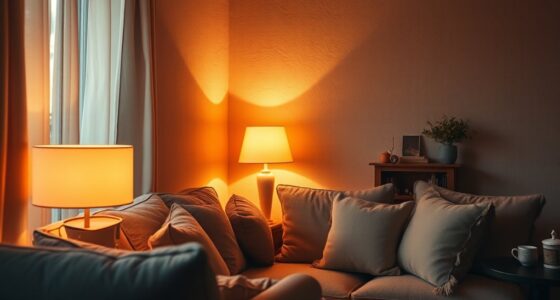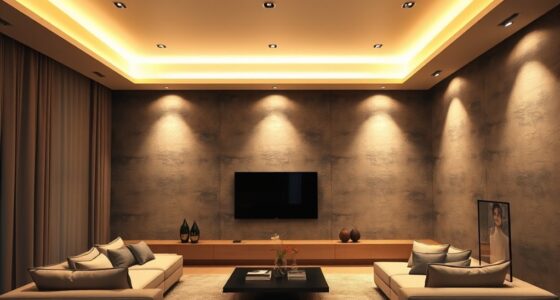To do layered lighting right, start with a soft ambient layer that provides overall brightness without overpowering the space. Add task lighting where activities happen, like under-cabinet lights or desk lamps, to boost functionality. Highlight features with accent lighting, such as spotlights or picture lights, to create visual interest. When you combine these layers thoughtfully, your space becomes inviting, balanced, and functional. Keep exploring to discover how to perfect this lighting approach for any room.
Key Takeaways
- Establish a balanced foundation with soft, even ambient lighting to create a comfortable atmosphere.
- Use targeted task lighting to enhance functionality for specific activities while minimizing shadows and glare.
- Highlight focal points and decorative elements with accent lighting to add depth and visual interest.
- Ensure proper placement and intensity of each layer to maintain harmony and avoid over-illumination.
- Control all layers with dimmers or smart systems for adjustable ambiance and optimal space usability.
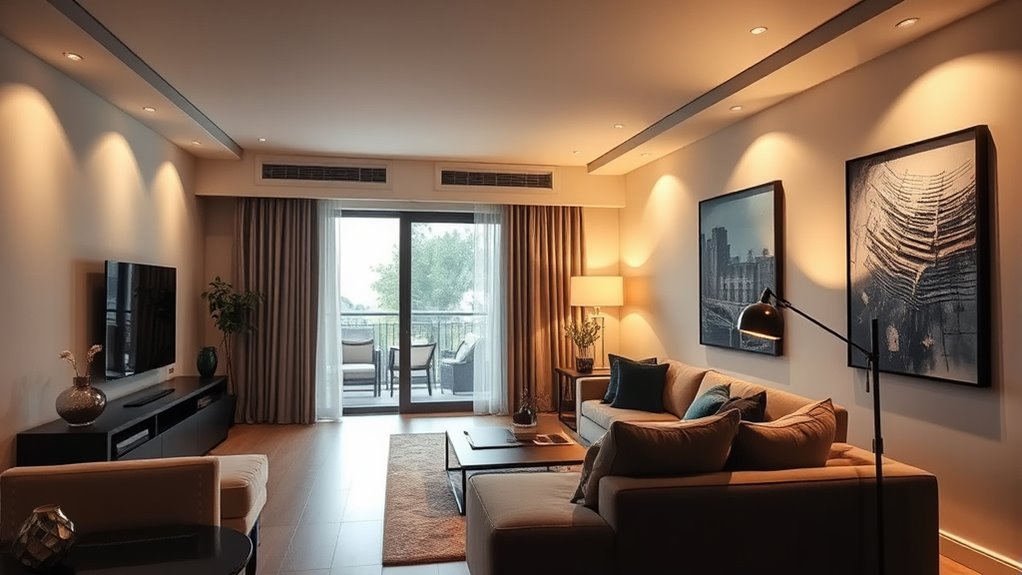
Have you ever wondered how to create a truly versatile and inviting space through lighting? The secret lies in understanding layered lighting and how to balance ambient, task, and accent layers effectively. Proper lighting design transforms a plain room into a welcoming environment, emphasizing aesthetic harmony while serving practical needs. When you approach lighting with this layered blueprint, you gain control over mood, functionality, and style, making your space both beautiful and functional.
Layered lighting creates versatile, inviting spaces by balancing ambiance, task, and accent layers for style and function.
Start with ambient lighting, which provides the overall illumination for your room. Think of it as the foundation of your lighting design. It should be soft, even, and unobtrusive, setting the tone without overwhelming the space. Recessed lights, ceiling-mounted fixtures, or large pendant lights work well here. The goal is to create a comfortable glow that fills the room without casting harsh shadows. When you plan your ambient lighting carefully, you guarantee the space feels cohesive and inviting, with enough light to move around safely. This layer also plays an essential role in establishing aesthetic harmony—by choosing fixtures that complement your room’s style, you enhance the overall look and feel.
Next, incorporate task lighting to cater to specific activities. This layer is all about practicality. Whether you’re reading, cooking, working, or applying makeup, you need focused light that minimizes eye strain and highlights details. Desk lamps, under-cabinet lighting, or adjustable wall sconces are perfect for task lighting. Position these fixtures strategically to avoid shadows and glare. When done correctly, task lighting not only boosts functionality but also adds depth and interest to your space. It helps you zone areas and emphasizes design elements, creating a balanced composition within your layered lighting scheme. Additionally, layered lighting can support the health of your eyes by reducing strain and fatigue, especially when using lighting that aligns with the activity’s needs.
Finally, add accent lighting to highlight features and create visual interest. This layer involves carefully placed fixtures that draw attention to artwork, architectural details, or decorative elements. Spotlights, picture lights, or LED strips are common choices here. Accent lighting adds contrast and drama, giving your room personality and dimension. It’s vital to be selective with this layer, as too much can clutter the space or disrupt aesthetic harmony. When you master the art of accent lighting, you craft focal points that guide the eye and elevate your overall design.
Frequently Asked Questions
How Do I Balance All Three Lighting Layers Effectively?
You need to master the lighting hierarchy by balancing ambient, task, and accent lighting. Start with strategic fixture placement to guarantee each layer complements the others without overpowering. Use dimmers for flexibility, adjusting brightness as needed. Focus on even distribution, so no one layer dominates. Combining different fixture types and placement techniques creates a harmonious layered effect, making your space functional, inviting, and visually appealing.
What Are Common Mistakes in Layered Lighting Design?
Think of your lighting as a symphony—mistakes can drown out the harmony. You often see issues like mismatched color temperature, which creates a disjointed feel, or poor fixture placement that causes glare or shadows. These errors disrupt the balance, making spaces uncomfortable. To avoid this, guarantee your fixtures complement each other in color and are strategically placed, creating a seamless flow that enhances every layer without overwhelming or underlighting.
How Can I Save Energy With Layered Lighting?
To save energy with layered lighting, you should incorporate motion sensors and dimmer switches into your design. Motion sensors automatically turn off lights when a room’s unoccupied, reducing unnecessary energy use. Dimmer switches let you adjust light levels based on need, cutting down on excess electricity. By combining these tools, you maximize energy efficiency while maintaining a comfortable, functional space. This approach guarantees you’re using lighting wisely and sustainably.
Which Fixtures Are Best for Accent Lighting?
When selecting fixtures for accent lighting, focus on spotlighting techniques that highlight artwork, architectural features, or decor. Opt for adjustable fixtures like track lights or directional spotlights, which allow you to control the focus and direction of light. Consider LED fixtures for energy efficiency and long-lasting performance. Your fixture selection should enhance the space’s ambiance without over-illuminating, creating a balanced and inviting atmosphere.
How Do I Adapt Lighting Layers for Small Spaces?
To adapt lighting layers for small spaces, you should focus on compact fixtures that save space while providing sufficient light. Use multi-purpose bulbs in versatile fixtures to serve multiple layers, like ambient and accent lighting, without cluttering the area. Incorporate adjustable or wall-mounted lights to maximize functionality and flexibility. This approach guarantees your small space feels well-lit, cozy, and functional without overwhelming the room.
Conclusion
So there you have it—your foolproof plan to turn any room into a well-lit masterpiece, or at least make it look like you know what you’re doing. With ambient, task, and accent lighting working together, you’ll impress friends, family, and maybe even yourself. Just remember, if all else fails, hide the ugly wires behind a fancy lamp—because nothing says “designer” like a little sneaky concealment. Happy lighting!
